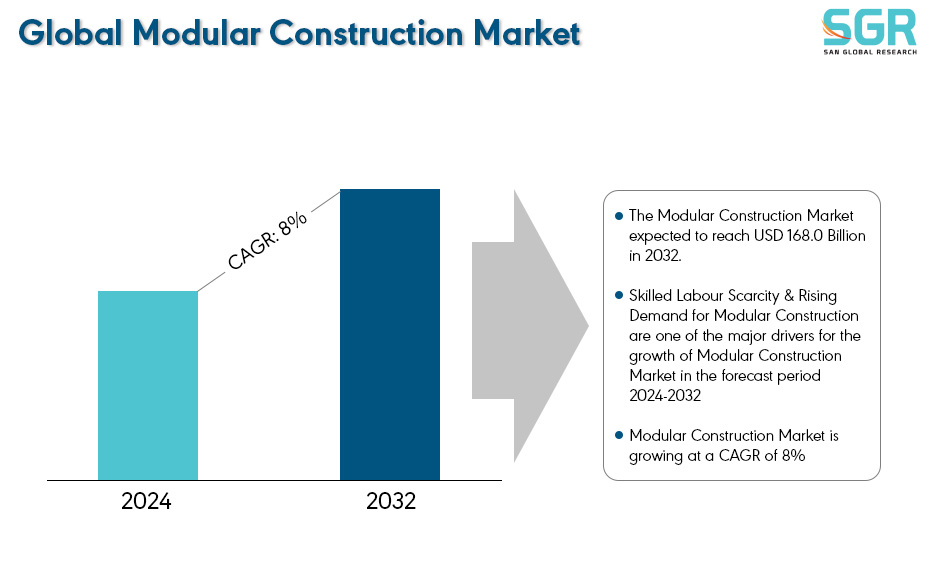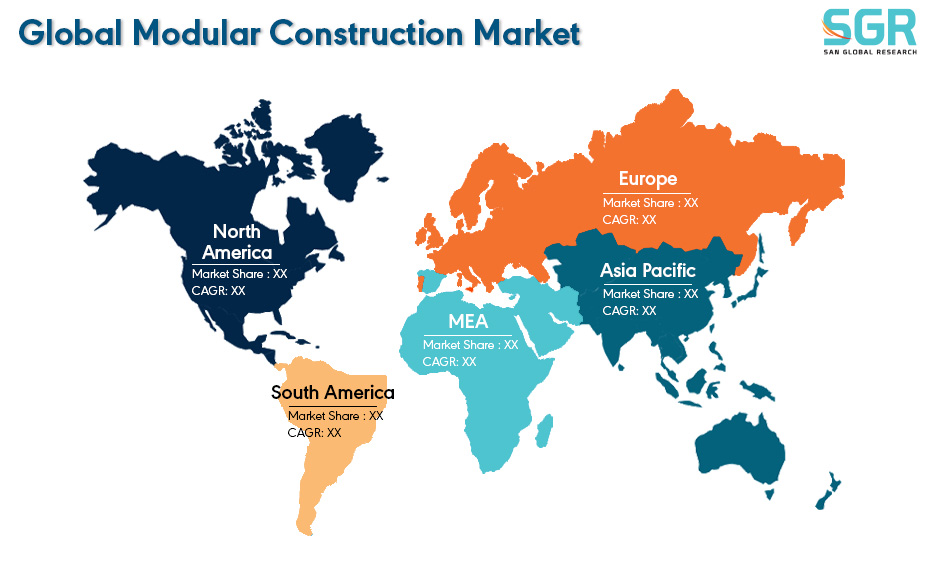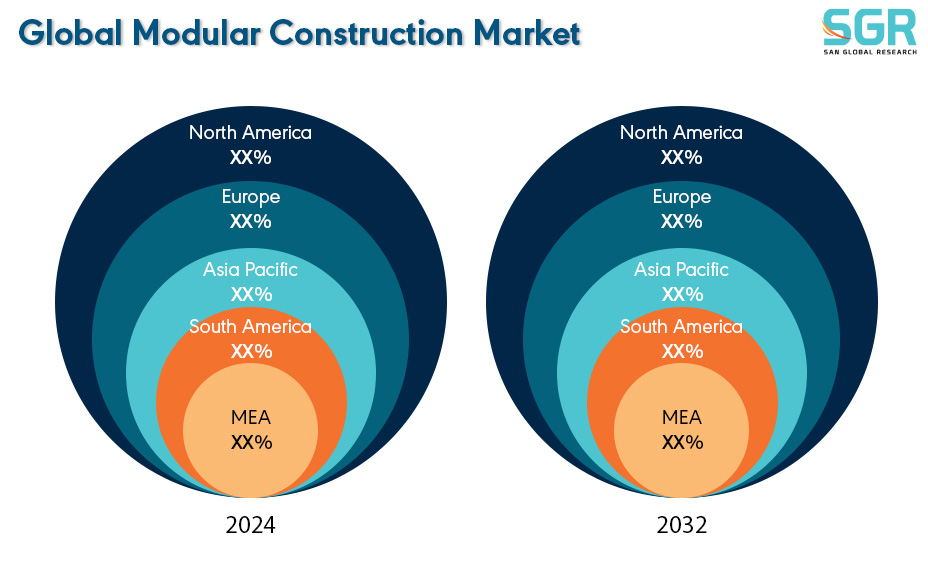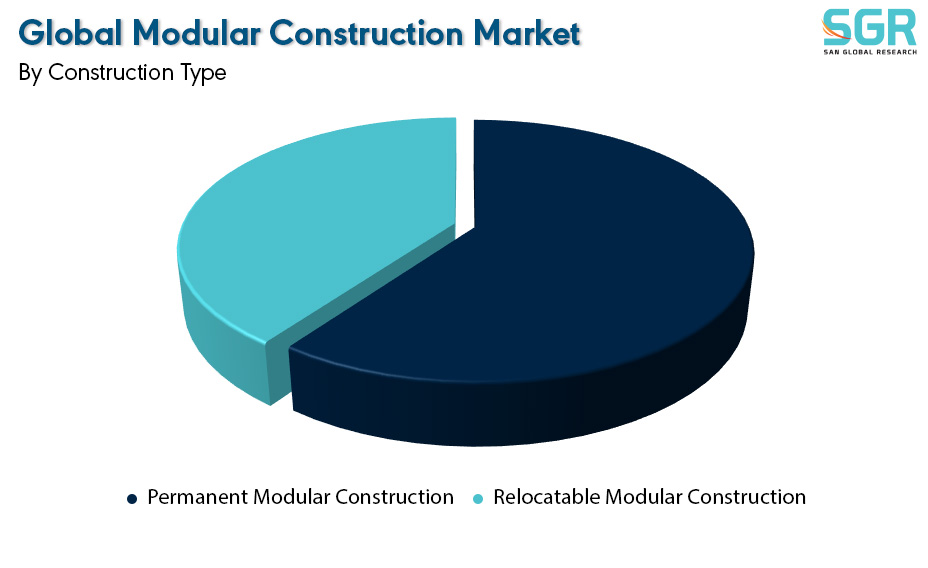Modular Construction Market is estimated to be worth USD 90.7 Billion in 2024 and is projected to grow at a CAGR of 8% between 2024 to 2032. The study has considered the base year as 2023, which estimates the market size of the market, and the forecast period is 2024 to 2032. The report analyzes and forecasts the market size, in terms of value (USD Billion), for the market. The report segments the market and forecasts it by Construction Type, by Material, by End User, and by region/country.

Modular construction, basically is a process of manufacturing numerous building sections in a facility for assembly at a remote building site. The modules called as the building sections which will fit together once assembled on site with plumbing and electrical connections running throughout. One of the major benefits within the modular construction process is that many of the process happens at a same time which can reduce the construction time in half. While outlining to make sure all the connections fit together properly involves some complexity. To understand the modular construction process easily, it can be broken down into seven steps such as Design, Engineering, Permits & Approvals, Site Development, Plant Fabrication, Transportation, and Installation.

In modular construction, shipping containers comes in two basic sizes which are 20 feet by 8 feet and 40 feet by 8 feet. The smaller one provides approximately 160 square feet of living space, while the larger one offers 320 square feet. There is also height type based modules such as regular (8.5 feet height) or a high cube container that be provide about a foot extra vertical living space.

After reviewing the data shown below, it can be determined that the Asia Pacific region dominates the Modular Construction Market for the following reasons.
The Asia Pacific region is gaining significant traction within the Modular Construction market due to the increasing population by which the demand of housing infrastructure is increasing significantly. Government initiatives such as Pradhan Mantri Awas Yojana (PMAY), which was initiated to provide affordable housing India is also driving the region towards the respective market growth. China being the largest construction market and also due to the implementations of the new infrastructure project within China’s 14th five-year plan in energy, water systems transportations and new urbanization it is to be estimated that the overall investment within the new infrastructure during the five-year plan period (2021-2025) will reach roughly around $4.2 trillion which is driving the Asia Pacific region to significantly dominates the Modular Construction Market.

Segmentations
By Construction Type
Based on Construction Type, the Modular Construction Market is bifurcated into Permanent Modular Construction and Relocatable Modular Construction – where Permanent Modular Construction are dominating and ahead in terms of share. The Permanent Modular Construction is dominating the construction segment within the Modular Construction Market due to various aspects such being cost effective than the tradition methods by an 11%, even the construction time was reduced by an average of 42% and also due to the prefabrication process within the construction reduces the onsite material waste significantly due to which the Permanent Modular Construction segment is dominating the Modular Construction market significantly.

By Material
Based on Material, the Modular Construction Market is bifurcated into Steel, Concrete, Wood and Others– where Steel are dominating and ahead in terms of share.

By End Users
Based on End Users, the Modular Construction Market is bifurcated into Residential, Commercial, Institutional, Industrial and Healthcare – where Residential end users are dominating and ahead in terms of share.

Key Players
• Sekisui House Ltd.
• LAING O'ROURKE
• Red Sea International
• Skanska
• Bouygues Construction
Drivers
Skilled Labour Scarcity & Rising Demand for Modular Construction
Due to the skilled labour shortage in the construction industry is driving the modular construction market significantly. The labour shortage is being experienced within the countries such as the U.S, U.K, India, Bahamas etc. As construction industry has been an important factor for the in the GDP of many countries around the world, to tackle these grim situation various countries have adopted the modular construction method where the demand for this kind of construction has been substantially increased mitigating the labour shortage within the construction industry which is significantly driving the market growth for the modular construction market.
Opportunity
Technological Advancements
The technological advancements within the industry has opened significant market growth opportunity for the modular construction market. The fibre reinforced polymer (FRP) composites as potential replacements for concrete, timber and steel have been a significant technological advancement within the modular construction industry. Even the ductility of the GFRP wood sandwich beam under static loading can be also increased by the help of the layered based construction systems in beams, which has a potential to increase the pseudo- ductility. The FRP also has a great potential for the residential construction.
| Report Attribute | Details |
| Market Value in 2024 | 90.7 Billion |
| Forecast in 2032 | 168.0 Billion |
| CAGR | CAGR of 8% from 2024 to 2032 |
| Base Year of forecast | 2023 |
| Historical | 2019-2022 |
| Units | Revenue in USD Million and CAGR from 2024 to 2032 |
| Report Coverage | Revenue forecast, Industry outlook, Competitive Landscape, Growth Factors, and Trends |
| Segments Scope | By Construction Type, By Material, By End User |
| Regions Covered | North America, Europe, Asia Pacific, SA and MEA |
| Key Companies profiled | • Sekisui House Ltd. • LAING O'ROURKE • Red Sea International • Skanska • Bouygues Construction |

 Description
Description
 Table of Content
Table of Content
 Gera Imperium Rise,
Gera Imperium Rise,  +91 9209275355
+91 9209275355


